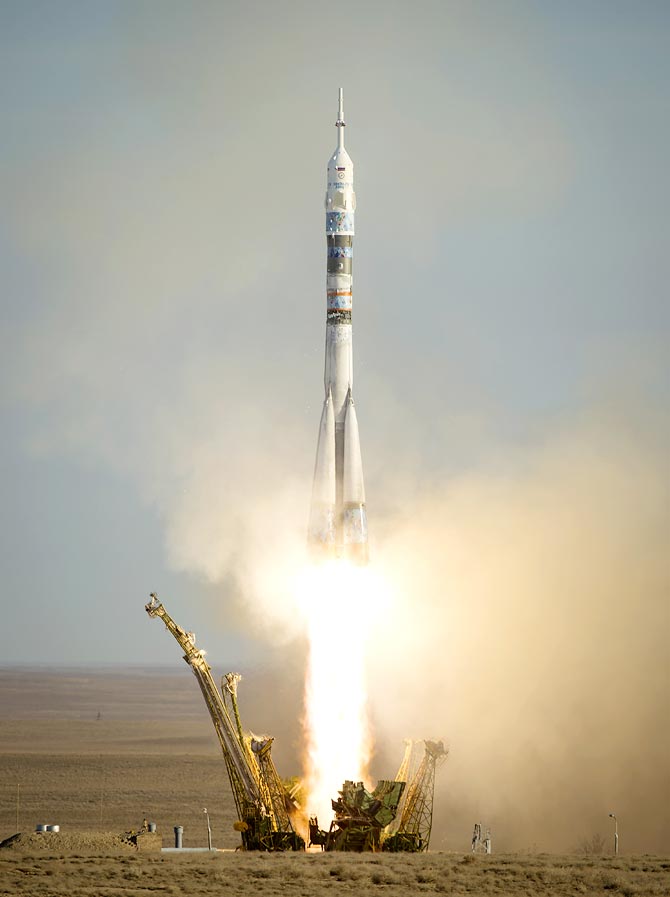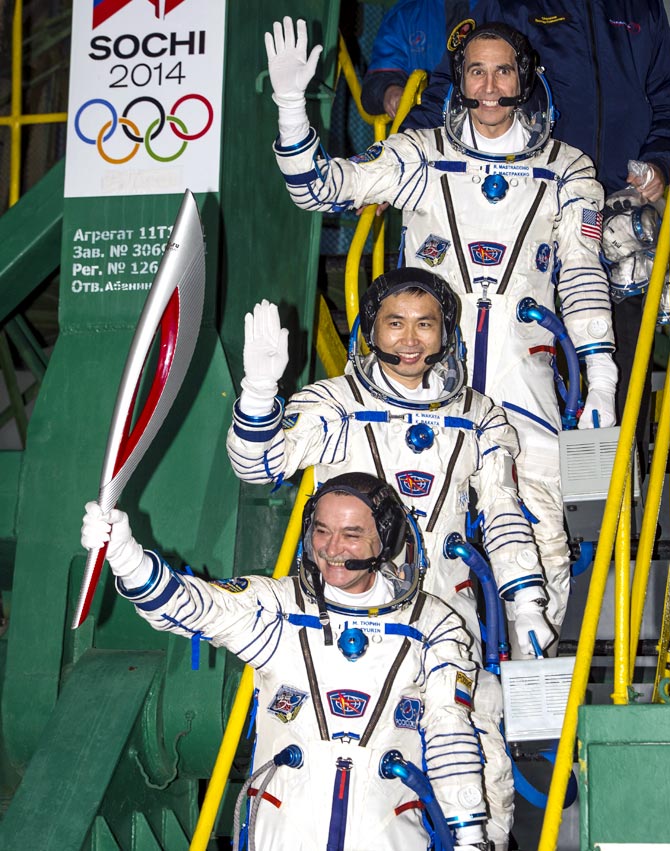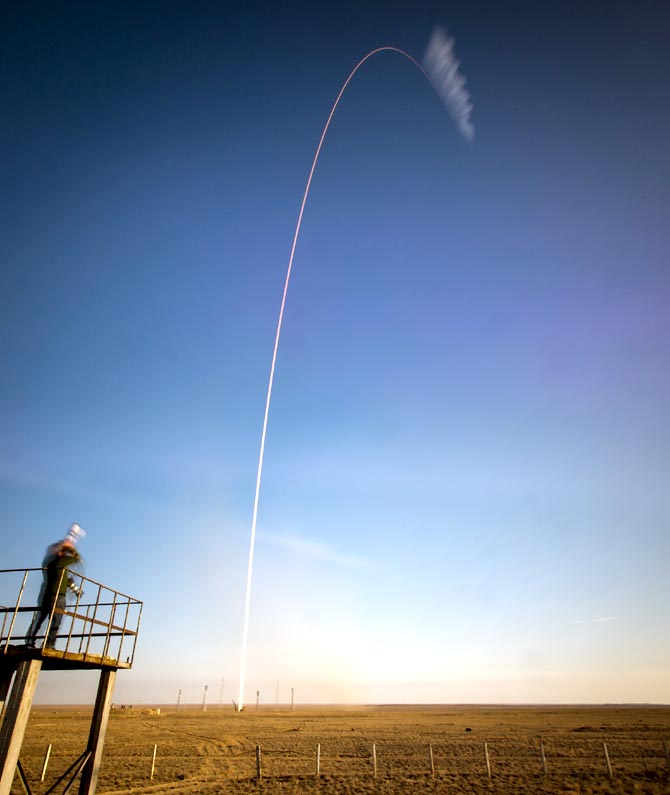Photographs: Bill Ingalls/NASA via Getty Images
A three-man crew successfully blasted off into space with the Olympic torch on Thursday, ready to take it on its first space walk in what they said would be a "spectacular" showcase for the 2014 Winter Games in Sochi.
Japan's Koichi Wakata pumped the air with his fist as the Soyuz rocket, painted with snowflake patterns, took off on a crisp morning, an onboard camera showed. The crew sat beneath a stuffed polar bear wrapped in a blue scarf, a Sochi mascot.
The space flight is part of what will be the longest torch relay before a Winter Olympics, which President Vladimir Putin hopes will boost Russia's image and show what it can achieve, more than two decades after the Soviet Union collapsed.
'We will have a kind of relay of our own with this torch'
Image: Expedition 38 Soyuz Commander Mikhail Tyurin of Roscosmos, holding the Olympic torch, Flight Engineer Koichi Wakata of the Japan Aerospace Exploration Agency, and, Flight Engineer Rick Mastracchio of NASA (top), wave farewell prior to boarding the Soyuz TMA-11M rocket for launchPhotographs: Bill Ingalls/NASA via Getty Images
Less than six hours after the launch, Russian Mikhail Tyurin, American Rick Mastracchio and Wakata will deliver the torch to the International Space Station.
"It's just an outstanding day and a spectacular launch," William Gerstenmaier, NASA's associate administrator for human exploration and operations, said.
"I get the privilege of understanding what goes on behind the scenes ... It's not easy and it is not routine. It is still a marvel to me when I see it."
Their families and other spectators watched the rocket disappear into the blue sky, leaving a trail of blazing light. Mission control announced: "Soyuz TMA-11M is in the orbit" to applause.
For safety reasons, the torch will not be lit in what could be a relief for Russia after the flame went out several times since the relay began last month.
"We will have a kind of relay of our own with this torch," veteran cosmonaut Tyurin, 53, told a news conference at the Baikonur cosmodrome, which Moscow rents from Kazakhstan, on the eve of his launch.
Tyurin will hand off the torch to fellow cosmonauts Oleg Kotov and Sergei Ryazansky, who will take it outside the airlock on Saturday.
'We'd like to showcase our Olympic torch in space'
Image: Olympic rings are seen at the Soyuz launch pad shortly after the Soyuz TMA-11M rocket was erected into position at the Baikonur Cosmodrome in Baikonur, KazakhstanPhotographs: Bill Ingalls/NASA via Getty Images
The Olympic torch has gone into space twice before, in 1996 and 2000, but it has never been taken on a space walk.
"Our goal here is to make it look spectacular," Kotov told reporters before his mission began. "We'd like to showcase our Olympic torch in space ... Millions of people will see it live on TV and they will see the station and see how we work."
While the red-and-silver torch, designed to evoke the feathers of a Firebird from Russian folklore, is taken outside space station 250 miles (400 km) above Earth, the flame will remain lit on the ground below.
As well as replacing the gas flame, Russian engineers have equipped the torch with a tether to keep it from floating out of the cosmonauts grip in weightlessness. "It was reworked ... so that it doesn't fly away," said Sergei Krikalev, head of the Cosmonauts' Training Centre outside Moscow.
The torch travelled to the North Pole on an atomic-powered ice breaker.
Image: In this handout photo provided by NASA, The Soyuz TMA-11M rocket, in the two minute exposure during its launchPhotographs: Bill Ingalls/NASA via Getty Images
As part of its 65,000-km (40,000-mile) relay, the torch has travelled to the North Pole on an atomic-powered ice breaker.
It will still go to the peak of Europe's highest mountain, Mount Elbrus, and the depths of Siberia's Lake Baikal before reaching Sochi on the Black Sea for the start of the Games on February 7.
"The Olympics are a huge international event that takes many, many countries cooperating and working together to pull off such a tremendous event," Mastracchio, 53, told reporters.
"So in a small way, I think it's great that we bring this symbol up to the international space station, which is another representation of international cooperation."
The torch-bearing trio's arrival at the orbital station, a $100 billion project of 15 nations, will briefly swell its crew to nine people - the most on board the outpost since America's last shuttle mission in 2011.
The torch will be brought back to Earth by Russian Fyodor Yurchikhin, American astronaut Karen Nyberg and European Space Agency astronaut Luca Parmitano on November 11.






Comment
article